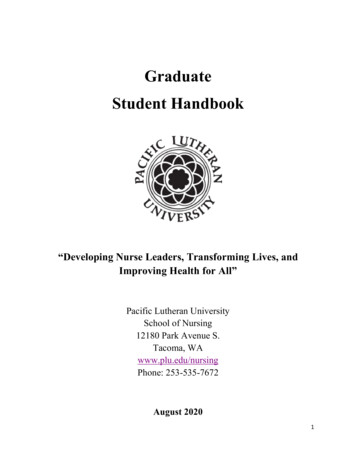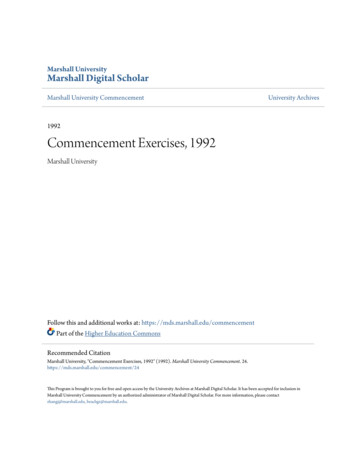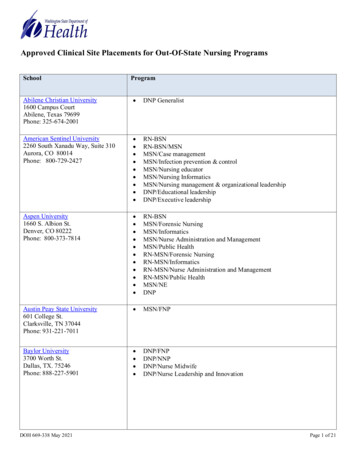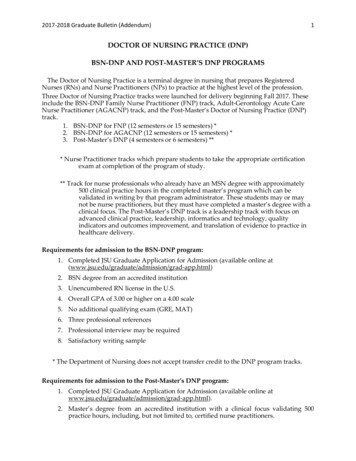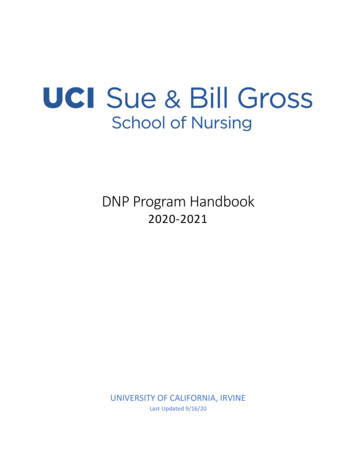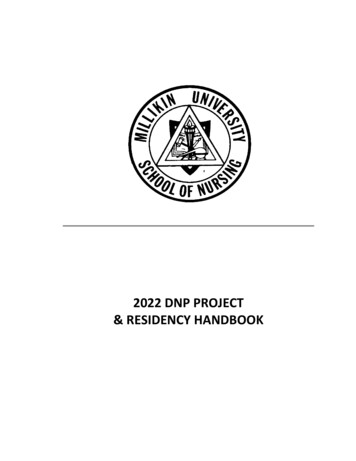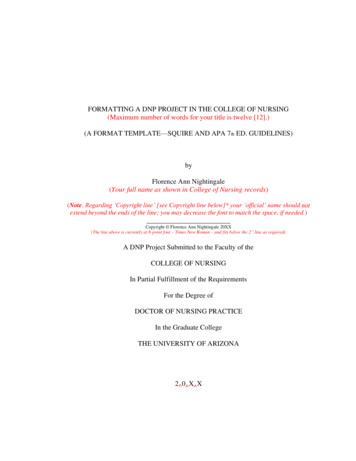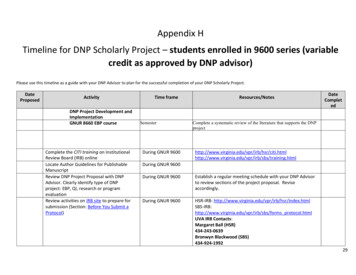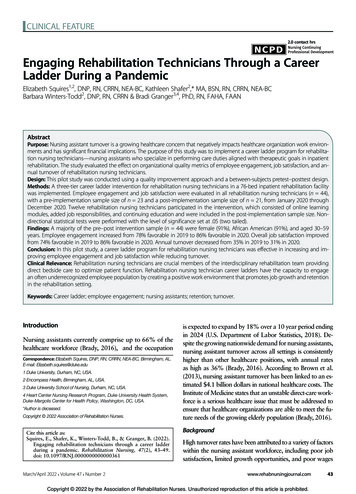
Transcription
Nurse Manager’sGuide to Retention& RecruitmentJune Marshall, DNP, RN, NEA-BCCole Edmonson, DNP, RN, FACHE, NEA-BC, FAANVictoria England, MBA, BSN, RN, NE-BC
Nurse Manager’sGuide to Retention& RecruitmentJune Marshall, DNP, RN, NEA-BCCole Edmonson, DNP, RN, FACHE, NEA-BC, FAANVictoria England, MBA, BSN, RN, NE-BC
Nurse Manager’s Guide to Retention & Recruitment is published by HCPro, an H3.Group division ofSimplify Compliance LLC.Copyright 2017 HCPro, an H3.Group division of Simplify Compliance LLC.All rights reserved. Printed in the United States of America.5 4 3 2 1Download the additional materials of this book at www.hcpro.com/downloads/12635.ISBN: 978-1-68308-495-2No part of this publication may be reproduced, in any form or by any means, without prior writtenconsent of HCPro or the Copyright Clearance Center (978-750-8400). Please notify us immediately if youhave received an unauthorized copy.HCPro provides information resources for the healthcare industry.HCPro is not affiliated in any way with The Joint Commission, which owns the JCAHO and Joint Commission trademarks.June Marshall, DNP, RN, NEA-BC, AuthorCole Edmonson, DNP, RN, FACHE, NEA-BC, FAAN, AuthorVictoria England, MBA, BSN, RN, NE-BC, AuthorKenneth Michek, Associate EditorMichelle Clarke, Managing EditorErin Callahan, Vice President, Product Development & Content StrategyElizabeth Petersen, Executive Vice President, HealthcareMatt Sharpe, Production SupervisorVincent Skyers, Design Services DirectorVicki McMahan, Sr. Graphic DesignerAngel Cruz, Layout/Graphic DesignTyler Oswald, Cover DesignerAdvice given is general. Readers should consult professional counsel for specific legal, ethical, or clinicalquestions. Arrangements can be made for quantity discounts. For more information, contact:HCPro35 Village Road, Suite 200Middleton, MA 01949Telephone: 800-650-6787 or 781-639-1872Fax: 800-639-8511E-mail: customerservice@hcpro.comVisit HCPro online at www.hcpro.com and www.hcmarketplace.com.
Table of ContentsAbout the Authors . . . . . . . . . . . . . . . . . . . . . . . . . . . . . . . . . . . . . . . . . . . . . . . . . . . . viiNursing Education Instructional Guide. . . . . . . . . . . . . . . . . . . . . . . . . . . . . . . . . . . . ixTarget Audience. . . . . . . . . . . . . . . . . . . . . . . . . . . . . . . . . . . . . . . . . . . . . . . . . . . . . . . . . . ixChapter 1: Nurse Turnover: Realities, Risks, and Prevention. . . . . . . . . . . . . . . . . . . . 1Modern-Day Healthcare . . . . . . . . . . . . . . . . . . . . . . . . . . . . . . . . . . . . . . . . . . . . . . . . . . . . 1Nurse Leaders, the Endangered Species of Nursing . . . . . . . . . . . . . . . . . . . . . . . . . . . . . . 2Costs of Turnover and High Vacancy Rates . . . . . . . . . . . . . . . . . . . . . . . . . . . . . . . . . . . . . 3Retaining Nurses. . . . . . . . . . . . . . . . . . . . . . . . . . . . . . . . . . . . . . . . . . . . . . . . . . . . . . . . . . . 4Chapter 2: Embracing Diversity in the Workplace. . . . . . . . . . . . . . . . . . . . . . . . . . . 11Types of Diversity. . . . . . . . . . . . . . . . . . . . . . . . . . . . . . . . . . . . . . . . . . . . . . . . . . . . . . . . . . 11Multigenerational Workforce Challenges and Opportunities . . . . . . . . . . . . . . . . . . . . . 13Creating and Sustaining Diversity-Sensitive Care Environments. . . . . . . . . . . . . . . . . . . . 16Valuing Diversity. . . . . . . . . . . . . . . . . . . . . . . . . . . . . . . . . . . . . . . . . . . . . . . . . . . . . . . . . . 18Summary. . . . . . . . . . . . . . . . . . . . . . . . . . . . . . . . . . . . . . . . . . . . . . . . . . . . . . . . . . . . . . . . 19Chapter 3: Developing Nurse Managers and Leaders as ChiefRetention Officers. . . . . . . . . . . . . . . . . . . . . . . . . . . . . . . . . . . . . . . . . . . . . . . . . . . . . 21Leading by Example. . . . . . . . . . . . . . . . . . . . . . . . . . . . . . . . . . . . . . . . . . . . . . . . . . . . . . . 21Onboarding and Ongoing Leadership Development . . . . . . . . . . . . . . . . . . . . . . . . . . . . 22Successful Recruitment, Candidate Selection, Interviewing, and Hiring . . . . . . . . . . . . . 25 2017 HCPro, an H3.Group division of Simplify Compliance, LLCNurse Manager’s Guide to Retention & Recruitment iii
Table of ContentsManagers’ Role in Building, Engaging, and Retaining High-PerformingNursing Teams. . . . . . . . . . . . . . . . . . . . . . . . . . . . . . . . . . . . . . . . . . . . . . . . . . . . . . . . . . . 27Summary. . . . . . . . . . . . . . . . . . . . . . . . . . . . . . . . . . . . . . . . . . . . . . . . . . . . . . . . . . . . . . . . 30Chapter 4: Employee- and Family-Friendly Policies and Programs . . . . . . . . . . . . . 33Create an Environment of Care, Concern, and Respect. . . . . . . . . . . . . . . . . . . . . . . . . . 33Employee- and Family-Friendly Policies, Programs, and Practices. . . . . . . . . . . . . . . . . . 36Putting Ideas Into Practice. . . . . . . . . . . . . . . . . . . . . . . . . . . . . . . . . . . . . . . . . . . . . . . . . . 40Summary. . . . . . . . . . . . . . . . . . . . . . . . . . . . . . . . . . . . . . . . . . . . . . . . . . . . . . . . . . . . . . . . 41Chapter 5: Developing Professional Models of Care. . . . . . . . . . . . . . . . . . . . . . . . . 43From Theory to Practice. . . . . . . . . . . . . . . . . . . . . . . . . . . . . . . . . . . . . . . . . . . . . . . . . . . . 43Chapter 6: Quality Improvement Systems and Workforce Retention . . . . . . . . . . . 51Relationships Matter: Quality and Retention . . . . . . . . . . . . . . . . . . . . . . . . . . . . . . . . . . . 51Using Performance Improvement Strategies to Address Workforce Outcomes. . . . . . . . 52Create a Workplace Environment Council. . . . . . . . . . . . . . . . . . . . . . . . . . . . . . . . . . . . . 53Identifying, Monitoring, and Analyzing Metrics That Matter . . . . . . . . . . . . . . . . . . . . . . . 53Balancing Stability and Change: Weighing Risks and Benefits. . . . . . . . . . . . . . . . . . . . . 55Strategies for Recruiting and Retaining a Balanced Workforce—Addressing CurrentNeeds While Planning for the Future. . . . . . . . . . . . . . . . . . . . . . . . . . . . . . . . . . . . . . . . . . 55Leadership Presence . . . . . . . . . . . . . . . . . . . . . . . . . . . . . . . . . . . . . . . . . . . . . . . . . . . . . . 57Chapter 7: Ensuring Interdisciplinary Collaboration. . . . . . . . . . . . . . . . . . . . . . . . . 59Communication: Emerging Technology and Team Strategies for Success . . . . . . . . . . . 59Changing Roles in Changing Times: The Importance of Collaboration to AchieveDesired Results and Patients as Partners in Care . . . . . . . . . . . . . . . . . . . . . . . . . . . . . . . 60Capitalizing on Diverse Strengths and Styles . . . . . . . . . . . . . . . . . . . . . . . . . . . . . . . . . . . 61Matching Teams With Tasks. . . . . . . . . . . . . . . . . . . . . . . . . . . . . . . . . . . . . . . . . . . . . . . . . 62Leading in Clinical Microsystems: Breaking Down Silos and RemovingPower Gradients . . . . . . . . . . . . . . . . . . . . . . . . . . . . . . . . . . . . . . . . . . . . . . . . . . . . . . . . . 63iv Nurse Manager’s Guide to Retention & Recruitment 2017 HCPro, an H3.Group division of Simplify Compliance, LLC
Table of ContentsCare Transitions and Teams Across the Continuum . . . . . . . . . . . . . . . . . . . . . . . . . . . . . 65Summary. . . . . . . . . . . . . . . . . . . . . . . . . . . . . . . . . . . . . . . . . . . . . . . . . . . . . . . . . . . . . . . . 67Chapter 8: Professional Development . . . . . . . . . . . . . . . . . . . . . . . . . . . . . . . . . . . . 69Role-Specific Professional Development—Embarking on the Leadership Journey . . . . . 69Developing Formal and Informal Leaders. . . . . . . . . . . . . . . . . . . . . . . . . . . . . . . . . . . . . . 72Discerning Career Paths in Nursing: Developing, Engaging, and RetainingBest Talent and Finding the Best Role ‘Fit’. . . . . . . . . . . . . . . . . . . . . . . . . . . . . . . . . . . . . . 75Career Enhancement Programs That Support Role Development . . . . . . . . . . . . . . . . . . 76Summary. . . . . . . . . . . . . . . . . . . . . . . . . . . . . . . . . . . . . . . . . . . . . . . . . . . . . . . . . . . . . . . . 78Chapter 9: Recognition and Reward Programs That Promote Retention . . . . . . . . 79The Importance of Recognition and Reward Programs—Not Just About the Money!. . . 79Create a Plan for the Future. . . . . . . . . . . . . . . . . . . . . . . . . . . . . . . . . . . . . . . . . . . . . . . . . 84Building the Business Case for Recruitment and Retention Programs . . . . . . . . . . . . . . . 84Summary. . . . . . . . . . . . . . . . . . . . . . . . . . . . . . . . . . . . . . . . . . . . . . . . . . . . . . . . . . . . . . . . 89Chapter 10: Establishing Academic Partnerships to Build a Successful Pipeline. . . 91Academic Partnership Programs: Assessing the Landscape and Selectingthe Right Partner . . . . . . . . . . . . . . . . . . . . . . . . . . . . . . . . . . . . . . . . . . . . . . . . . . . . . . . . . 91Partnering With High School Health Professions Programs . . . . . . . . . . . . . . . . . . . . . . . . 93Successfully Managing Student Affiliations . . . . . . . . . . . . . . . . . . . . . . . . . . . . . . . . . . . . 93Forging Clinical Faculty Opportunities for Internal Staff . . . . . . . . . . . . . . . . . . . . . . . . . . 95Innovative Practicum Programs to Increase Students’ Exposure to SpecialtyAreas With Hard-to-Fill Positions/Vacancies . . . . . . . . . . . . . . . . . . . . . . . . . . . . . . . . . . . 96Externships, Internships, and Residencies as Recruitment and Retention Strategies . . . 97Summary . . . . . . . . . . . . . . . . . . . . . . . . . . . . . . . . . . . . . . . . . . . . . . . . . . . . . . . . . . . . . . . 99 2017 HCPro, an H3.Group division of Simplify Compliance, LLCNurse Manager’s Guide to Retention & Recruitment v
Table of Contents Chapter 11: Power of Metrics . . . . . . . . . . . . . . . . . . . . . . . . . . . . . . . . . . . . . . . . . . 101Changing the Paradigm . . . . . . . . . . . . . . . . . . . . . . . . . . . . . . . . . . . . . . . . . . . . . . . . . . 101From Data to Wisdom: Making Sense of It All. . . . . . . . . . . . . . . . . . . . . . . . . . . . . . . . . . 103Strategic Planning Around the Workforce. . . . . . . . . . . . . . . . . . . . . . . . . . . . . . . . . . . . . 104Workforce Planning Trends and Issues: Considerations for the Future . . . . . . . . . . . . . . 105Summary. . . . . . . . . . . . . . . . . . . . . . . . . . . . . . . . . . . . . . . . . . . . . . . . . . . . . . . . . . . . . . . 106Chapter 12: Strengths and Opportunities: What Works and What Doesn’t . . . . . . 107Common Mistakes and How to Avoid Them . . . . . . . . . . . . . . . . . . . . . . . . . . . . . . . . . . 107Recipes for Success . . . . . . . . . . . . . . . . . . . . . . . . . . . . . . . . . . . . . . . . . . . . . . . . . . . . . . 108Learning From Industries Outside Healthcare . . . . . . . . . . . . . . . . . . . . . . . . . . . . . . . . . 110What Employees Seek in ‘Best Places to Work’ Environments . . . . . . . . . . . . . . . . . . . . . 111Appendix: Additional Tools and Resources. . . . . . . . . . . . . . . . . . . . . . . . . . . . . . . 115Selecting the right candidates . . . . . . . . . . . . . . . . . . . . . . . . . . . . . . . . . . . . . . . . . . . . . 115Celebrating nurses’ accomplishments and contributions . . . . . . . . . . . . . . . . . . . . . . . 115Incentives Index . . . . . . . . . . . . . . . . . . . . . . . . . . . . . . . . . . . . . . . . . . . . . . . . . . . . . . . . . 116Seeking employee feedback. . . . . . . . . . . . . . . . . . . . . . . . . . . . . . . . . . . . . . . . . . . . . . . 117vi Nurse Manager’s Guide to Retention & Recruitment 2017 HCPro, an H3.Group division of Simplify Compliance, LLC
About the AuthorsDr. Cole Edmonson, DNP, RN, FACHE, NEA-BC, FAANDr. Cole Edmonson, DNP, RN, FACHE, NEA-BC, FAAN, has a career spanning two decades withroles including clinical nurse, supervisor, manager, director, associate chief nursing officer, and hiscurrent position of chief nursing officer. He is a fellow in the American Academy of Nursing and theAmerican College of Healthcare Executives and Nursing Executive Advanced Board Certified by ANCC.He is a Robert Wood Johnson Foundation Executive Nurse Fellow Alum. He completed his BSN andMSN at Oklahoma University College of Nursing and his Doctor of Nursing Practice (DNP) at TexasChristian University. He is a contributor to the literature, locally and nationally, in the area of leadership, succession planning, research, moral courage, nurse bullying, culture building, emerging globalhealth issues, and Magnet . Edmonson is a speaker in academic and professional settings, locally andnationally, on topics ranging from Magnet, research, leadership, succession planning, moral courage,nurse bullying, customer service, chronic obstructive pulmonary disorder, genetics/genomics, emergingglobal health issues, and the IOM future of nursing. He is the creator of two antibullying websites.Edmonson is a true nursing advocate who believes, espouses, and actively works to create leadersfrom the bedside to the boardroom, empowering them to lead. He creates environments wherenurses are valued, are respected, have integrity of practice, and clearly demonstrate their contributions at all levels. He has led two organizations to Magnet and Magnet redesignation in the DFWarea, one being the first to accomplish this in the area, and the second being the fourth to be redesignated in Dallas, both as a Magnet Project Director and a Chief Nursing Officer. He has been a primary investigator and a coinvestigator on numerous national and local nursing research studiesranging from Just Cultures to genetics/genomics competencies for nurses. He is a cocreator of thegenetics/genomics toolbox for the NIH/NHGP/NCI. He is a mentor to staff nurses and both emergingand experienced leaders in healthcare, with his influence being felt outside of nursing. He was theprimary architect of the “Just Culture” created in a large facility in Dallas and continues that role asthe Safe Choices (Just Culture) Champion in his current facility, setting the foundation for the high-reliability transformation of the organization. 2017 HCPro, an H3.Group division of Simplify Compliance, LLCNurse Manager’s Guide to Retention & Recruitment vii
About the AuthorsVictoria England, MBA, BSN, RN, MBA, NE-BCVictoria England, MBA, BSN, RN, NE-BC, is the director of the Office of Nursing Excellence,overseeing the Magnet accreditation in Dallas, Texas. In this role, she works with the executiveleadership team and direct care staff in promoting nurse excellence thoroughout the organization.Nurse retention and recruitment is her passion within hospital and ambulatory settings. She supportsthe professional nurse in both practice and policy as the past chair of governmental affairs committeefor Texas Nurses Association and a practice committee member. She stays current on global nursingthrough her participation with Texas Team Coalition.England is a local, national, and international speaker on nursing professional practice, quality, andpatient/family-centered care. Her professional involvement includes past vice president of TexasNurses Association, ANA Delegate, current president of the Dallas-Fort Worth Great 100 Nurse Recognition, and executive board member of North Texas Organization of Nurse Executives. Her passionfor representing the professional nurse throughout Dallas-Fort Worth drove her to become a memberof the inaugural class of Nurses on Boards. England received a Master of Business Administrationfrom Amberton University and a Bachelor of Nursing from University of Texas at Arlington. She iscurrently pursuing her Doctorate of Nursing Practice.Dr. June Marshall, DNP, RN, NEA-BCDr. June Marshall, DNP, RN, NEA-BC, has a long, diverse career in nursing spanning more thanfour decades. Her roles include direct care nurse, clinical nurse specialist, nurse entrepreneur andconsultant, educator, researcher, and nurse leader. Marshall received her BSN from Texas Woman’sUniversity, MS (Nursing) from Virginia Commonwealth University-Medical College of Virginia, andDoctorate of Nursing Practice from Texas Christian University. She is certified as a Nurse ExecutiveAdvanced by the American Nurses Credentialing Center. Dr. Marshall has diverse experience from avariety of healthcare settings, including freestanding children’s hospitals, large academic medicalcenters, rehabilitation settings, community medical centers, and large healthcare systems. She has along history of professional association involvement, serving in various leadership roles in TexasNurses Association, North Texas Organization of Nurse Executives, and DFW Great 100 Nurses, Inc.Dr. Marshall has tremendous commitment to excellence in nursing and has collaboratively led twoorganizations to achieve Magnet designation. She has served as a facilitator for nursing sharedgovernance councils, led Nursing Peer Review Committees for four organizations, and has long beencommitted to advocacy for nurses. She has taught leadership development for nurse supervisors,managers, and directors and serves as adjunct faculty for students in a DNP in a Nursing Administration program. Dr Marshall has numerous articles and presentations on a wide variety of clinical,research, and leadership topics. Her passion is focused on creating and sustaining healthy workenvironments for nurses that attract and retain the best and brightest nurses in all roles.viii Nurse Manager’s Guide to Retention & Recruitment 2017 HCPro, an H3.Group division of Simplify Compliance, LLC
Nursing EducationInstructional GuideTarget AudienceNurse manager, assistant nurse manager, nurse leader, nursing director, VP of nursing, chief nursingofficer, charge nurse, patient care manager, ancillary services managers, staff educators, nursingprofessional development specialists, staff development directorsStatement of needWith the current shortage of nurses in the system, recruiting and retaining the best has implicationsfor nurses at all levels of practice and across all care delivery settings. This book is a user-friendlyguide for nurse leaders which will assist with sound theoretical perspectives, evidence-based practices, practical strategies, and tools for achieving the best recruitment, engagement, and retentionoutcomes for their organization.Educational objectives1.Identify megatrends in nursing2.Understand costs and risks3.Identify interventions to impact turnover and break the cycle4.Identify types and significance of workplace diversity5.Describe strategies for addressing generational workforce challenges6.Assess and manage diversity-related workforce issues 2017 HCPro, an H3.Group division of Simplify Compliance, LLCNurse Manager’s Guide to Retention & Recruitment ix
Nursing Education Instructional Guide7.Identify key recruitment and retention leadership competencies8.Describe successful candidate interview and selection strategies9.Explain methods for engaging and retaining best talent10. Describe important elements in employee-friendly workplace policies11. Explain practices that promote healthy work-life balance12. Identify strategies that promote manager-employee relationships and build trust13. Build programs based on employees’ feedback and needs14. Understand theoretical grounding for professional models of care—theory and reality15. List key components of professional practice model16. Discuss shared governance—employees’ roles in shared decision-making17. Describe building and sustaining healthy interprofessional team relationships18. Apply frontline leadership as an engagement strategy—ownership of professional practiceand outcomes19. Discern the relationship between quality outcomes and workforce retention20. Use performance improvement strategies to address workforce outcomes21. Identify, monitor, and analyze metrics that matter22. Balance stability and change while weighing risks and benefits23. Implement strategies for recruiting and retaining a balanced workforce, addressing currentneeds while planning for the future24. Explain the role of emerging technology in team communication25. Describe strategies for success in interprofessional team collaboration26. Identify the role of individual strengths and styles in high-performing teams27. Implement interprofessional collaborative teamwork within clinical microsystems, through caretransitions, and across the continuum28. Identify role-specific professional development paths29. Describe strategies for developing formal and informal leaders30. Explain the importance of professional development in engaging and retaining nurses31. Align career enhancement programs to support professional role development32. Describe important elements of staff recognition in the workplace33. Identify ways to reward staff34. List essential aspects of the performance review that enhance retention35. Identify strategies that promote manager-staff relationships36. Identify strengths in academic partners to best match service organization needsx Nurse Manager’s Guide to Retention & Recruitment 2017 HCPro, an H3.Group division of Simplify Compliance, LLC
Nursing Education Instructional Guide37. Define strategies for attracting high school students into healthcare careers38. Explain key components in managing affiliations with academic partners39. Explore models that provide opportunities to increase faculty resources40. Describe mechanisms for academic-service partnership programs to support recruitmentand retention41. Focus on retention rates instead of measuring turnover—risks and opportunities42. Monitor local, regional, and national trends—finding meaning in the metrics43. Use metrics in strategic planning to meet unit, department, and organization workforce needs44. Understand workforce planning trends and issues—considerations for the future45. Explain two common mistakes in recruiting and retaining the best employees46. Understand key strategies for successful recruitment and retention47. Identify best practices in industries outside healthcareFacultyJune Marshall, DNP, RN, NEA-BCCole Edmonson, DNP, RN, FACHE, NEA-BC, FAANVictoria England, MBA, BSN, RN, NE-BCAccreditation/Designation statementHCPro is accredited as a provider of continuing nursing education by the American Nurses Credentialing Center’s Commission on Accreditation.This educational activity for 3.5 contact hours is provided by HCPro, a division of BLR.Nursing contact hours for this activity are valid from October 1, 2017 – October 1, 2020.Disclosure statementsThe planners, presenters/authors, and contributors of this CNE activity have disclosed no relevantfinancial relationships with any commercial companies pertaining to this activity.InstructionsIn order to successfully complete this CNE activity and be eligible to receive your nursing contacthours for this activity, you are required to do the following: 2017 HCPro, an H3.Group division of Simplify Compliance, LLCNurse Manager’s Guide to Retention & Recruitment xi
NursingInstructional GuideChapterEducation 1.Read the book: Nurse Manager’s Guide to Retention & Recruitment2.Go online to www.hcpro.com/downloads/126353.Follow the CE Instructional Guide4.Complete the exam and receive a passing score of 80% or higher5.Complete and submit the evaluation6.Provide your contact information at the end of the evaluationA certificate will be emailed to you immediately following your submission of the evaluation and successful completion of the exam. Please retain this email for future reference.NOTEThis book and associated exam are intended for individual use only. If you would like to provide thiscontinuing education exam to other members of your nursing staff, please contact our customerservice department at 800-650-6787 to place your order. The exam fee schedule is as follows:Exam quantityFee1 02–25 15 per person26–50 12 per person51–100 8 per person101 5 per personxii Nurse Manager’s Guide to Retention & Recruitment 2017 HCPro, an H3.Group division of Simplify Compliance, LLC
1Nurse Turnover:Realities, Risks, and PreventionCole Edmonson, DNP, RN, FACHE, NEA-BC, FAANLEARNING OBJECTIVESAfter reading this chapter, thelearner should be able to: Identify megatrends innursingModern-Day HealthcareToday’s healthcare system is hallmarked by complexity, complexity that is best described as increasing and more rapid Understand costs and riskschange than perhaps any other time in history. It is an exciting Identify interventions toimpact turnover and breakthe cycletime to be in healthcare, especially to be a nurse. Opportunitiesabound, needed transformation is happening, and change isafoot. The change is fueled by the effects of the increasingpercentage of gross domestic product that is unsustainable, theAffordable Care Act (and its possible replacement), the growingtechnology area, the tidal wave of the aging population, increasing life span and chronic illness burden in an already overburdened system with a growing shortage of healthcare providers,restrictions that prevent professions from practicing at the top ofcompetency, increasing violence against healthcare workers, andthe lifestyle choices being made by providers that exaggeratesthe growing access point and availability shortages.The graying and greening of the nursing workforce is in fulleffect, with many studies showing 20% under the age of 30 andmore than 75% are baby boomers and Generation X (Stokowski,2013). The impending retirement wave and brain drain stands to 2017 HCPro, an H3.Group division of Simplify Compliance, LLCNurse Manager’s Guide to Retention & Recruitment 1
Chapter 1worsen the nursing shortage, skill mix, tenure mix, and potentially the safety of patients. We areentering what will be one of the most severe nursing shortages we have seen in decades. The HealthResources and Services Administration (HRSA) workforce for nursing study projected an excess ofregistered nurses (RN) by 2025 of 340,000. However, many leading authorities and nursing organizations have criticized the study for failing to take into account numerous model changes and using amicrosimulation model that forecasts an excess, among other issues. Many states have now createdtheir own forecasts attempting to correct for the HRSA model assumptions. For example, Texas Centerfor Nursing Workforce Studies (2016) is forecasting a shortage of 59,770 nurses by 2030. Our mostvaluable assets in healthcare will become even scarcer, and impact on patients and communities willbe seen in the quality of, access to, and availability of care, if we don’t reverse the trend and addressthe issues that are driving nurses out of nursing.The prevalence of workplace violence, ranging from incivility to physical abuse, is increasing insociety, and hospitals and health systems reflect this trend. In one survey of Texas nurses, over 82%had experienced some form of workplace violence, with the most frequent occurrence being verbalab
Victoria England, MBA, BSN, RN, NE-BC Nurse Manager's Guide to Retention & Recruitment With the current nursing shortage, recruiting and retaining the best nurses . from Amberton University and a Bachelor of Nursing from University of Texas at Arlington. She is currently pursuing her Doctorate of Nursing Practice. Dr . June Marshall, DNP .
